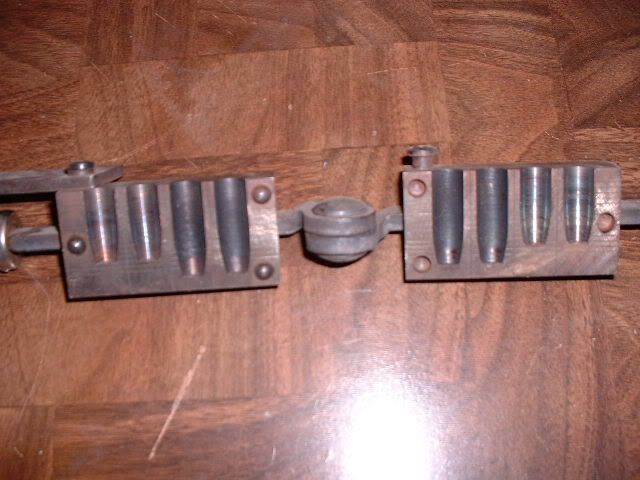| DarylS |
| (.700 member) |
| 07/04/16 03:04 PM |

|
|
|
I don't know anything about shooting PP bullets in a muzzleloading rifle. That is one discipline I never pursued, although for a time, was interested.
I don't need a wad or barrier between my cloth patched ball and the powder as I get 0 gas blowby.
If you are getting blowby, but not immediately visible, due to the patch not being burned or incinerated in worse-case scenarios, you can see the blowby's result if looking closely enough at a recovered patch.
Look at the base of the patch that was between the ball and the bore - if there is minor blowby, you will see a small brown streak - ie: scorch, radiating out towards the outside edge of the patch. This can be quite prevelent, or just barely seen. Any brown scorch mark from gasses getting past the patched ball, shows a weak combination & usually one that will not shoot as well as a tighter combination. Now, even though there is some minor blowby, you may still never need to wipe the bore while shooting, but it will generally not be as accurate as it can be.
If there is ANY blowby, the patch is too thin, or the ball too small. It's a rather simple problem to fix, ie: thicker patch, or larger ball - or perhaps both if the patches are completely incinerated. Had one guy on a different forum note that he had to wipe just about every shot, but could never find any spent cloth patches. I suggested he get down on his hands and knees and looks for black, burnt shards of twisted cloth. He checked again and indeed, found those. He wanted to load by pushing the patched ball into the muzzle with his thumb and I told him if he did not need a short starter to get a tight ball and patch started, he'd never get the accuracy nor clean shooting we enjoy.
When shooting lubed conicals in a BP ctg. rifle, I generally place a hard card wad between the bullet and the powder - 1/16" to 1/8" thick. I use an alloy that will allow the black powder blast to upset the bullet to fill the grooves. Thus, if the bullet will obturate to fill the grooves, and the lube is of the proper type (BP lube) and of sufficient quantity, there will be no leading and no hard crusty fouling. If the bore fouls towards the muzzle, more lube is needed and I use a grease cookie as noted below.
I like to use 50:50 WW and pure lead mix for BP grooved lubed bullets. The brinel # will be about 7 or 8.
For paper patched bullets, I use almost or pure lead and bullets that only just touch the lands AFTER patching. You can shove the patched bullet through the bore and it will have light marks on the paper patch where it rode the lands. This size of patched bullet can be seated out as far as you want or need and the fouled bore will not stop it as it will a groove diameter patched bullet. The lube ball between the 2 wax paper disks (the late Paul Mathews suggestion) will soften the fouling, breech to muzzle and leave a lube star at the muzzle. The reason for wax disks is to let the powder flame to melt & mix with the lube and spray it with the fouling onto the bore to keep the fouling soft. It works for me and my brother both, in our .45 3-1/4" chambers.
So - powder, then wax disk, the lube ball, then wax disk, then 1/10" card wad, then PP bullet. I came to prefer flat based bullets in my Sharps .45 3-1/4" as that is the mould we bored.
2 at 460gr., 2 at 580gr. My rifle preferred the 580gr. bullets. Taylor re-ground the nose of a fraction or number drill that cut a mould to case a .438" bullet. After patching, they came out at .4505". We plunge cut (drill press) an old Lyman 4-cavity .44 mag bullet mould, the #429303 I just happened to have. The cavities bored a bit rough, but no matter, 1.3" at 100 meters off bags was good enough for 5-shot groups. Mine RB rifle won the 300 meter match we put on locally, using this load. I think Taylor came in second or third with his Sharps. He used a similar load, but with more wads and a shorter 400gr. PP bullet. His rifle preferred a masking tape wrap for the paper. Go figure. It would shoot into 1 1/2" at 100 meters. That barrel only had 1 1/2 THOU deep rifling and this was the only "cast" bullet with black powder we could get to shoot smaller than a 6" group - for 8 years of trying.

If the bore fouls breech to muzzle, you did not use a black powder lube.
If the bore fouls only at the muzzle, you did not use enough lube.
If the bore fouls only at the breech, but not at the muzzle, the lube was too hard.
If after firing at least 6 shots, you cannot shove a dry patch through the bore and remove ALL fouling, you did not have sufficient lube to do the job required.
Note, the longer the barrel, the more lube you will need.